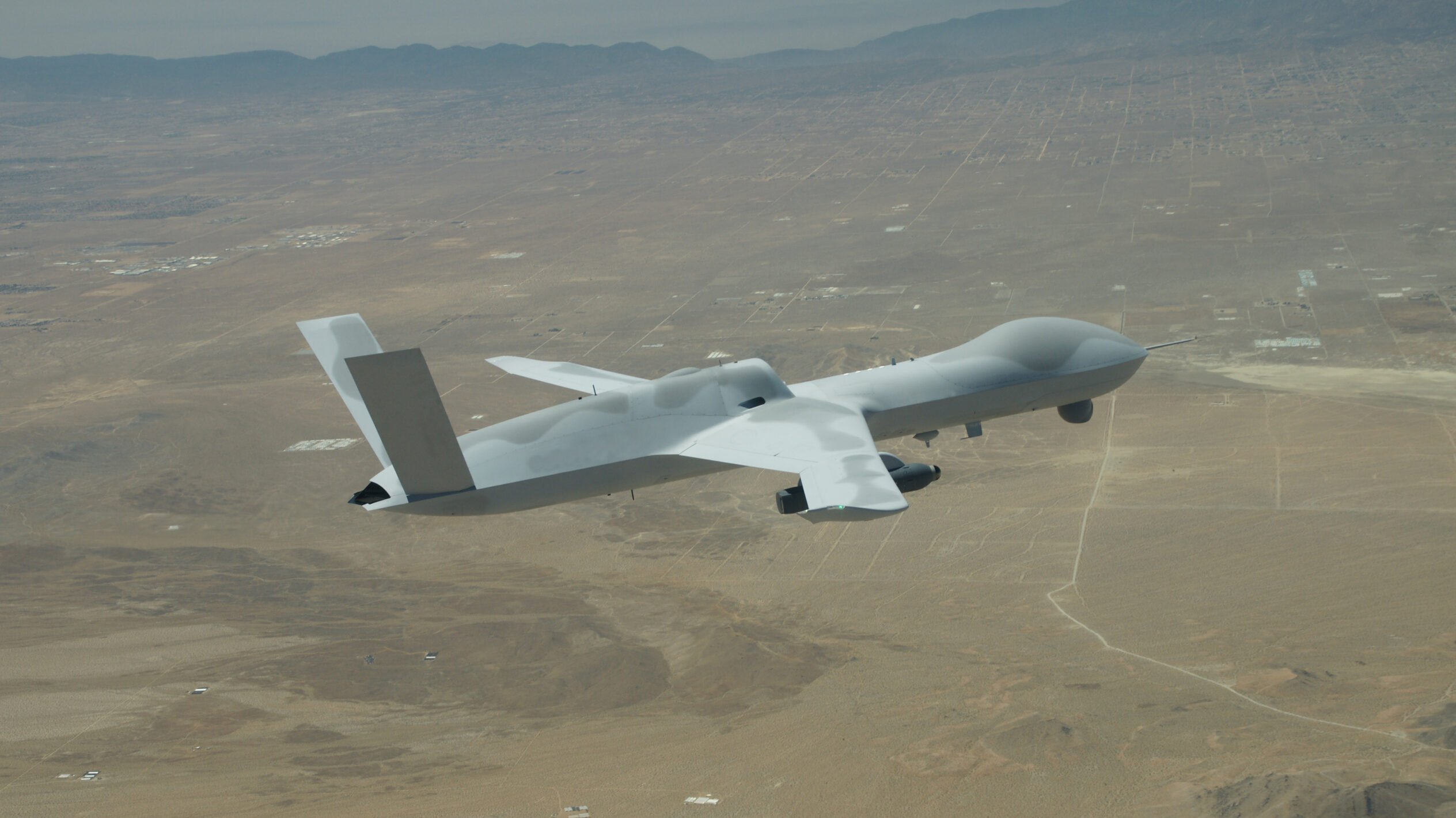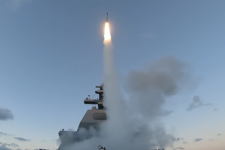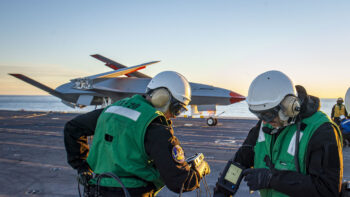
A General Atomics MQ-20 Avenger unmanned vehicle returns to El Mirage Airfield, Calif. June 24, 2021. The MQ-20 successfully participated in Edwards Air Force Base’s Orange Flag 21-2 to test the Skyborg Autonomy Core System. (General Atomics)
WASHINGTON — Over the past year, Air Force Secretary Frank Kendall has made it clear that “Loyal Wingman”-style combat drones, partnered with stealth fighters like the F-35 or its yet-to-be-revealed sixth-generation fighter, will be a key element of the service’s future tactical aircraft inventory.
Kendall’s vision is that pilots of aircraft such as the sixth-gen Next Generation Air Dominance fighter, F-35 and F-22 would be able to command one to five drones, “calling plays” that the drones would then be able to accomplish autonomously — although the decision to use a weapon will still fall to human operators.
But big questions still remain: Will the service begin what Kendall has called a “Collaborative Combat Aircraft” program of record in the upcoming fiscal 2024 budget? How many types of drones will it seek to procure? And what role will these novel aircraft play on future battlefields?
As the Air Force delineates the technologies that will make up its Next Generation Air Dominance family of systems — which is known to include a suite of CCA drones along with a manned, sixth generation fighter and the AIM-260 Joint Advanced Tactical Missile currently under development — its leadership is also drilling down on a strategy to rapidly develop and field CCA drones “in the mid to late 2020s,” Andrew Hunter, the Air Force’s top acquisition official, said in August.
RELATED: Air Force’s sixth generation fighter downselect ‘not all that far away,’ says Kendall
While the Air Force appears to have moved away from the “Digital Century Series” concept proposed by Hunter’s predecessor Will Roper for the manned NGAD fighter, Hunter said it could inform the acquisition strategy for CCA.
“The idea of the Digital Century Series is that you’re able to rapidly iterate designs. So you can make a lot of design progress in a short period of time, because you’re doing multiple design activities, in close proximity and/or simultaneously,” Hunter said at the Air Force’s Life Cycle Industry Days conference last month.
“I could see that approach being potentially really successful for a space where we think the design is going to need to iterate or could iterate quite a bit in a short period of time. And I would look at the Collaborative Combat Aircraft scenario where that could be the case,” he said. “We might ultimately decide that, that we want to pursue multiple approaches, at least up to a certain point. And that would be an area where that model could be relevant.”
However, there’s an ever-important caveat: the size of the defense budget.
“We are resource-constrained, and we are focused very much on capability,” Hunter said. “So we can’t afford to do four different kinds [of aircraft] where none of which actually develops into an operational capability.”
Ongoing Experiments — And Ongoing Questions
Over the past five or so years, the Air Force has made big investments in unmanned aircraft technologies, from the Low Cost Attritable Aircraft Technology program, which saw the service test out unmanned combat aircraft that are cheap enough to be lost in battle, to the Off Board Sensing Station effort — in which General Atomics and Kratos are developing low cost drones designed to carry modular sensor packages.
The most visible of these efforts is the notorious “Skyborg” program began in 2019 as one of the Air Force’s high-priority “Vanguard” technology demonstration projects. Under Skyborg, the service intends to build an “autonomy core system” (ACS) — basically a control system and common interfaces that can be swapped among different types of drones, allowing them to operate somewhat independently from a human pilot, but under common rules that the human pilot understands.
In this way, a human fighter pilot flying combat missions in the future could give commands to a number of drones under his or her control — instructions to fly in a certain direction and try to locate certain types of targets, for example — and the drones could accomplish those tasks without needing the pilot to physically fly the unmanned aircraft and operate its sensors.
“I think the most important thing is our ability to show that the autonomous core system was effective, and it can be moved from aircraft to aircraft,” said Brig. Gen. Dale White, the Air Force’s program executive for fighters and advanced aircraft. “We had two completely different vendors, two completely different aircraft, [and] we could use the autonomous control system on both.”
The Skyborg program logged its first flight test in April 2021 with the ACS onboard a Kratos UTAP-22 Mako. General Atomics’ MQ-20 Avenger made its first Skyborg flight in June 2021, followed by a later test in November when two MQ-20s flew under the control of the ACS. This July, Kratos acknowledged that two of its XQ-58A Valkyrie drones had also completed Skyborg test flights.
Boeing, which was one of the companies initially chosen for flight demonstrations, is no longer a participant in Skyborg, but could re-engage in future procure efforts, White said. Its MQ-28 Ghost Bat — formerly known as the Airpower Teaming System — was engaged in tests in Australia for its flagship customer, the Royal Australian Air Force, and schedule conflicts prevented Boeing from being able to provide a test aircraft for Skyborg.
“They did finally get a vehicle in the United States,” White said. “I think Boeing is continuing, on internal funds, the workings of that.”
While few details have been released regarding the scope of the testing and the maturity of the ACS, White said the program has been “foundational to building [the] confidence that we’re ready to move forward with CCA.”
The Air Force in its FY23 budget requested $52 million to begin transitioning Skyborg technologies, with plans to request another $52 million in FY24, according to budget documents. The future of that effort is ultimately opaque, with no other budget details laying out what the follow-on program will look like or how much it will ultimately cost. But White said that Skyborg development and testing still continues.
“We just flew again in June,” White said. “They’re still pushing out capability and continue to push the bounds of what we can do with autonomy, and that will definitely feed into [CCA].”
Steve Fendley, Kratos’ president of its unmanned systems division, demurred when asked about specifics of the XQ-58A Valkyrie’s latest flight tests or how the aircraft has been improved over the course of the Skyborg program. However, he noted a gradual shift in the way the Air Force plans to employ collaborative combat drones.
“When we first got into this part of the business … which was back in about 2015 with the Mako, we were very focused on control of the uncrewed aircraft from a crewed aircraft, kind of in a one-to-one ratio,” he told Breaking Defense in an August interview. What’s changed is an “increase in the need and desire to have the [unmanned] airplane be able to make a decision,” with a much greater focus on using multiple drones that are all capable of collecting data, and synthesizing that data in a way that provides a human pilot with recommendations.
While industry is still waiting for the Air Force to hand down formal requirements for CCAs, Fendley thinks it’s likely that the service ends up buying multiple types of drones, each with varying price points and capabilities, he said.
“I think what we’ll see is there’ll be low numbers of the very exquisite systems, and I think there’ll be very high numbers of attritables and expendables,” he said.






















